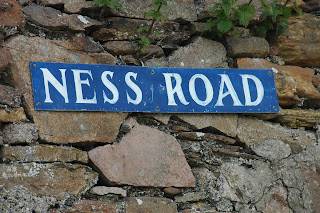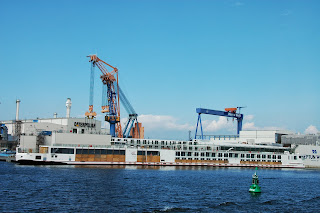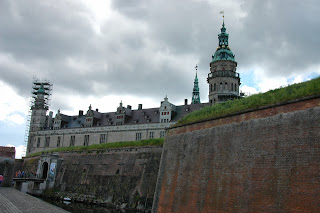After a brief couple of days we took the ‘van and headed up to Scotland
for a week exploring the East coast and Orkneys. Kate and Alan had travelled
ahead to “do” Edinburgh so we decided to meet near Stirling to do “Wallace”.
Our first visit was to the Wallace Memorial which importantly is a 246 steps
tower (or 220 ft) built in 1869. It gives a great view of Stirling castle which
overlooks the bend in the river where Wallace (Braveheart) inflicted his
significant defeat of the English way back in 1297. The English and their heavy
forces crossed the narrow bridge and when attacked spread out across the bank
as they could not all withdraw across the bridge. The ground being marshy
resulted in the horses and men slowly sinking where they could be picked off at
will. The English could have crossed the river further up but decided this was
too costly. 10 years late Robert Bruce used the same tactics to the same
effect. Some never learn from history.
At the foot of the memorial a Scots guide gave a vivid story of Wallace
and his eventual downfall in London where he was hung, drawn and quartered. The
guide was suitably armed with a sword, axe and several daggers which he at
various time wielded to add impact to his yarn.
Inside the tower the most memorable display was that of Wallace talking to
others (on a screen) within the room. The actor’s face was projected onto a
moulded head and looked very realistic as it spoke, smiled and sneered with
disdain at the English King.
His two handed sword is also on display – vital statistics - a 52 inch
blade and 66 inches long overall. In order to wield such a sword Wallace would
have to have been a large man – at least 6 ft 6 inches (not Mel Gibson at 5’
something).
We then made the short trip to the castle. This has been largely
refurbished in a manner similar to the original and had a number of suitably
attired people to answer questions. There are none so attentive as past
teachers.
The castle also overlooks the Wallace memorial although I am not sure this
cannon has the range.
We then travelled through the highlands via Balmoral. Unfortunately the
Queen was in so we could not visit her castle and had instead to put up with a
tour of the nearby Royal Lochnager distillery where some tasting (and
purchases) were in order. We then took the ‘van over the Cairngorms to the
North East tip of Scotland. Contrary to popular belief John O’Groats below is
not the most northerly point.
It is in fact Dunnet Head with the most North Easterly point being
Duncansby Head. A walk across the headland was warranted as seals could be
heard carrying on. With the distance and low light it was hard to pick whether
they were common or grey seals (most likely the former) but the cliffs really
acted as an amphitheatre and carried their cries a significant distance
notwithstanding the breeze. (Zoom in to see that there are many seals in this
small area.)
As Helen and I had never been, an overnight trip to the Orkneys was
appropriate. While waiting for the ferry we watched a fishing boat offloading
large bins of Haddock straight into articulated trucks for transport South.
The one hour forty minute ferry ride saw us in Stromness. Beautiful when the
sun is shining and it is calm.
We undertook a quick tour starting with Skara Brae which dates back to
3100 BC. (Compare this to the Great Wall of China 220 BC, Stonehenge 2100 BC or
the Pyramids of Giza 2500 BC.) The stone work was remarkably preserved together
with the stone flag furniture. The shelves in the middle were for displaying
things and the troughs at either side are beds where straw and skins would be
used to for a softer nights sleep.
We stopped overnight at a B&B in a converted mill. This
was a special evening as Helen and I celebrated our 40th wedding anniversary
(11 August). I was naturally happy at having been so lucky for so long and
Helen does not look too disappointed either. (If you look carefully the right
hand is displaying a new ruby ring from last years Burma trip.) We had a
wonderful meal and wines and as with recent anniversaries shared the occasion, in
this case with Kate and Alan who generously supplied champagne and a poster of
QV signed by the Captain. A great memoir.
Our second Orkney day included further exploring. A new discovery has been
made at the Ness of Brodgar which also dates back to 3200 BC. There were two
dozen student archaeologists fossicking around during their 6 week summer
break. They are over 2 years behind in working through the artefacts they have
found.
Nearby there are two rings of Stone – this is the Ring of Brodgar and at
104 metres across (with a further 10 metre ditch) is one of the largest Neolithic
Henges (circular enclosures) in Britain.
What initially infuriated most of us was that some people had recently carved their names into
some of the stones. However, this is hardly a new idea as S Bister did the same
back in 1881 (although I am not sure that makes it OK).
In Kirkwall there is St Magnus Cathedral which is huge. Wondering around
inside was enhanced by the organ playing which helped to distract attention
from the fact that many of the large supporting columns had a significant inward
lean.
We then travelled to the East end of Scapa flow where Churchill’s barrier
was built by Italian prisoners of war. The Italians in their spare time (and
despairing of the location and climate) decided to build a church out of two
Nissan huts. It is beautifully decorated.
Both outside and in..
Originally the East end of Scapa Flow was protected by sinking some ships
which can still be seen. However, when a German U boat managed to go over the
top and sink the HMS Royal Oak, Churchill ordered the construction of the barriers (which
run between three islands) using 10 Ton concrete blocks.
As we toured Stromness awaiting the ferry we could not help but notice
that a number of our family have had an impact on the towns development as recorded
by various signs.
During the ferry trip we passed the island of Hoy including the Old man of Hoy. Quite a spectacular stack at nearly 137 metres.
Helen and I have always enjoyed visits to Scotland but the Orkneys added a
quite different experience from the mainland.






















































